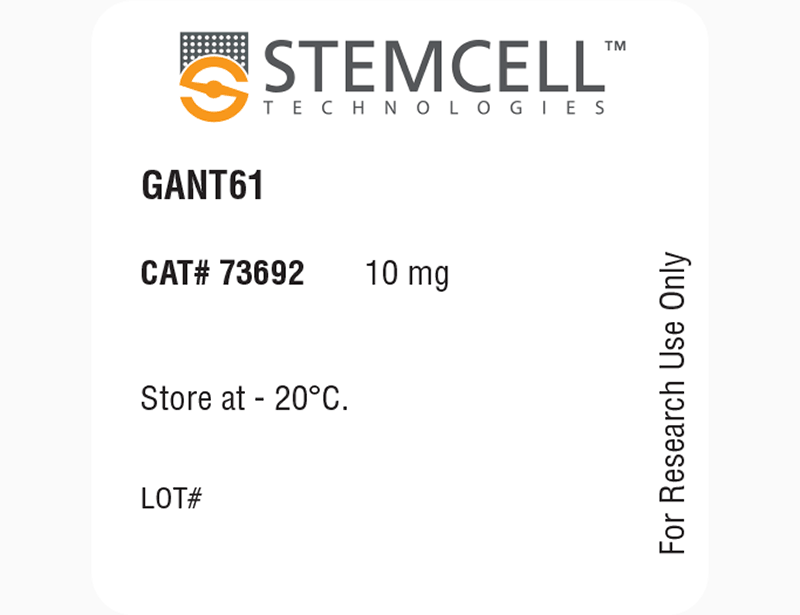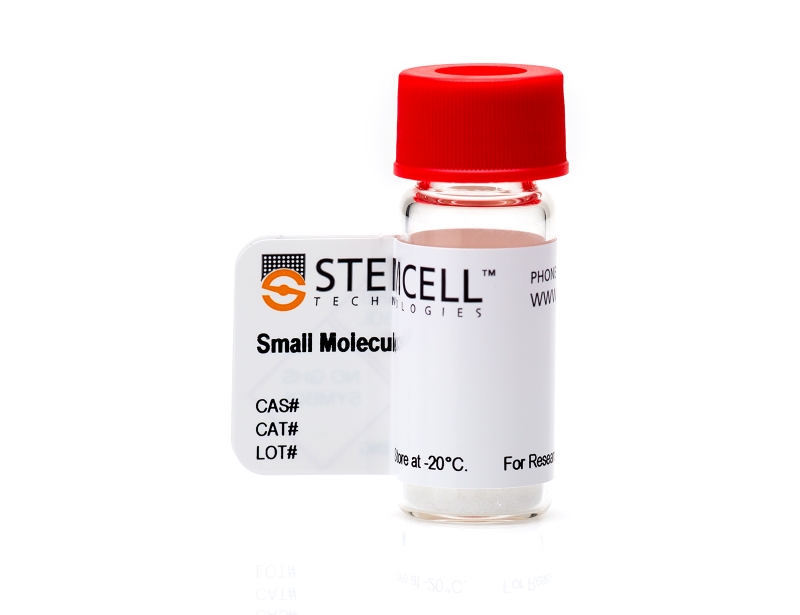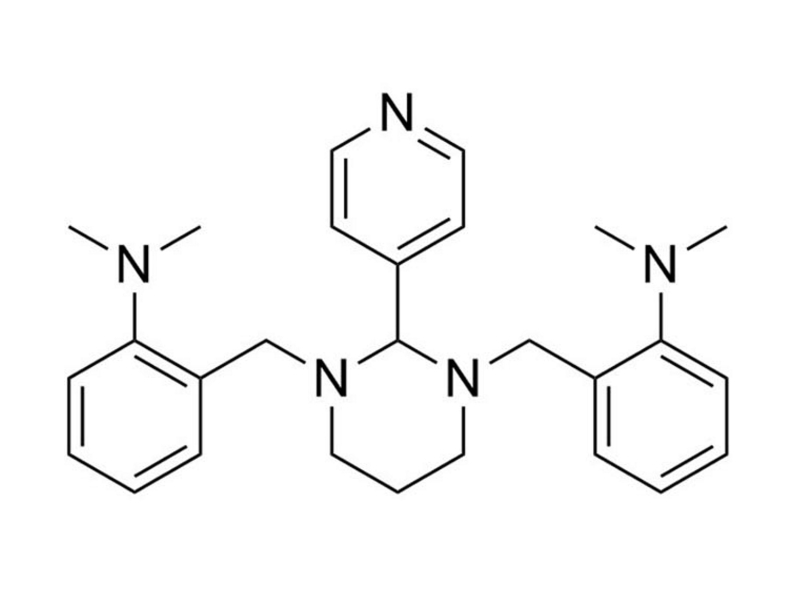GANT61
Hedgehog pathway inhibitor; Inhibits GLI
概要
GANT61 is a hexahydropyrimidine derivative which selectively inhibits GLI transcription factors in the Hedgehog signaling pathway. GANT61 acts downstream of Smoothened to inhibit both GLI1- and GLI2-mediated transcription (IC₅₀ = 5 μM in a GLI-transfected cell line) by preventing their DNA binding (Lauth et al.).
CANCER RESEARCH
· Inhibits in vitro proliferation of cancer cell lines (PANC1 and 22Rv1) with elevated GLI1 levels, and prevents the development of 22Rv1 tumors in mice (Lauth et al.).
· Inhibits pancreatic cancer stem cell growth in vitro and in mouse xenograft model (Fu et al.)
· Induces cell death of primitive neuroectodermal tumor cell line in a caspase-independent manner by inhibiting DNA replication (Matsumoto et al.).
· Causes apoptosis in myeloid leukemia cells and in some cell lines is more effective when combined with rapamycin (Pan et al.).
CANCER RESEARCH
· Inhibits in vitro proliferation of cancer cell lines (PANC1 and 22Rv1) with elevated GLI1 levels, and prevents the development of 22Rv1 tumors in mice (Lauth et al.).
· Inhibits pancreatic cancer stem cell growth in vitro and in mouse xenograft model (Fu et al.)
· Induces cell death of primitive neuroectodermal tumor cell line in a caspase-independent manner by inhibiting DNA replication (Matsumoto et al.).
· Causes apoptosis in myeloid leukemia cells and in some cell lines is more effective when combined with rapamycin (Pan et al.).
Alternative Names
NSC 136476
Cell Type
Cancer Cells and Cell Lines, Leukemia/Lymphoma Cells
Species
Human, Mouse, Rat, Non-Human Primate, Other
Area of Interest
Cancer Research
CAS Number
500579-04-4
Chemical Formula
C₂₇H₃₅N₅
Molecular Weight
429.6 g/mol
Purity
≥ 98%
Pathway
Hedgehog
Target
GLI
技术资料
| Document Type | 产品名称 | Catalog # | Lot # | 语言 |
|---|---|---|---|---|
| Product Information Sheet | GANT61 | 73692 | All | English |
| Safety Data Sheet | GANT61 | 73692 | All | English |
数据及文献
Publications (4)
Biological & pharmaceutical bulletin 2014 JAN
The GANT61, a GLI inhibitor, induces caspase-independent apoptosis of SK-N-LO cells.
Abstract
Abstract
GANT61 is a small-molecule inhibitor of glioma-associated oncogene 1 (GLI1)- and GLI2-mediated transcription at the nuclear level that exerts its effect by preventing DNA binding. It has been demonstrated to induce cell death against Ewing's sarcoma family tumor (ESFT) cell lines in a dose-dependent manner. The most sensitive cell line was SK-N-LO, which expresses the EWS-FLI1 fusion gene. SK-N-LO cells treated with GANT61 showed cellular and nuclear morphological changes, including cell shrinkage, chromatin condensation and nuclear fragmentation, in a concentration-dependent manner, as visualized by Hoechst 33342 staining. Furthermore, annexin V-propidium iodide (PI) double-staining revealed a significant increase in the number of late apoptotic cells. GANT61 induced a significant decrease in the proportion of cells in the S phase. Significant decrease of the protein levels of GLI2, survivin, cyclin A and claspin, and significant increase of p21 expression was also observed in the cells treated with GANT61. Moreover, poly (ADP-ribose) polymerase (PARP) cleavage was observed, but no cleavage of caspase-3 or -7, or any change in the expressions of Bcl-2 or p53 were observed. These findings suggest that GANT61 induces cell death of SK-N-LO cells in a caspase-independent manner, by inhibiting DNA replication in the S phase.
Cancer letters 2013 MAR
GANT-61 inhibits pancreatic cancer stem cell growth in vitro and in NOD/SCID/IL2R gamma null mice xenograft.
Abstract
Abstract
Multiple lines of evidence suggest that the Sonic Hedgehog (Shh) signaling pathway is aberrantly reactivated in pancreatic cancer stem cells (CSCs). The objectives of this study were to examine the molecular mechanisms by which GANT-61 (Gli transcription factor inhibitor) regulates stem cell characteristics and tumor growth. Effects of GANT-61 on CSC's viability, spheroid formation, apoptosis, DNA-binding and transcriptional activities, and epithelial-mesenchymal transition (EMT) were measured. Humanized NOD/SCID/IL2R gamma(null) mice were used to examine the effects of GANT-61 on CSC's tumor growth. GANT-61 inhibited cell viability, spheroid formation, and Gli-DNA binding and transcriptional activities, and induced apoptosis by activation of caspase-3 and cleavage of Poly-ADP ribose Polymerase (PARP). GANT-61 increased the expression of TRAIL-R1/DR4, TRAIL-R2/DR5 and Fas, and decreased expression of PDGFRα and Bcl-2. GANT-61 also suppressed EMT by up-regulating E-cadherin and inhibiting N-cadherin and transcription factors Snail, Slug and Zeb1. In addition, GANT-61 inhibited pluripotency maintaining factors Nanog, Oct4, Sox-2 and cMyc. Suppression of both Gli1 plus Gli2 by shRNA mimicked the changes in cell viability, spheroid formation, apoptosis and gene expression observed in GANT-61-treated pancreatic CSCs. Furthermore, GANT-61 inhibited CSC tumor growth which was associated with up-regulation of DR4 and DR5 expression, and suppression of Gli1, Gli2, Bcl-2, CCND2 and Zeb1 expression in tumor tissues derived from NOD/SCID IL2Rγ null mice. Our data highlight the importance of Shh pathway for self-renewal and metastasis of pancreatic CSCs, and also suggest Gli as a therapeutic target for pancreatic cancer in eliminating CSCs.
Leukemia research 2012 JUN
Gli inhibitor GANT61 causes apoptosis in myeloid leukemia cells and acts in synergy with rapamycin.
Abstract
Abstract
Aberrant reactivation of Gli signaling has been described in a wide variety of human cancers and rapamycin can down-regulate Gli pathway in some solid tumors. In this study, we attempt to define the cytotoxic effect of Gli inhibitor on AML cells. And the regulation action of rapamycin on Gli in AML cells also has been assessed. Gli inhibitor GANT61 caused growth arrest and apoptosis in AML cells. Rapamycin decreased not only the Gli protein and mRNA expressions but also expression of the Gli-luciferase reporter in AML cells. Synergism effect between GANT61 and rapamycin was found in Kasumi-1, HL-60 and U937 cell lines. The results suggest that aberrant Gli activation is a feature of some myeloid leukemic cells and Gli activiation can be down-regulated by rapamycin.
Proceedings of the National Academy of Sciences of the United States of America 2007 MAY
Inhibition of GLI-mediated transcription and tumor cell growth by small-molecule antagonists.
Abstract
Abstract
The developmentally important Hedgehog (Hh) signaling pathway has recently been implicated in several forms of solid cancer. Current drug development programs focus on targeting the protooncogene Smoothened, a key transmembrane pathway member. These drug candidates, albeit promising, do not address the scenario in which pathway activation occurs downstream of Smoothened, as observed in cases of medulloblastoma, glioma, pericytoma, breast cancer, and prostate cancer. A cellular screen for small-molecule antagonists of GLI-mediated transcription, which constitutes the final step in the Hh pathway, revealed two molecules that are able to selectively inhibit GLI-mediated gene transactivation. We provide genetic evidence of downstream pathway blockade by these compounds and demonstrate the ineffectiveness of upstream antagonists such as cyclopamine in such situations. Mechanistically, both inhibitors act in the nucleus to block GLI function, and one of them interferes with GLI1 DNA binding in living cells. Importantly, the discovered compounds efficiently inhibited in vitro tumor cell proliferation in a GLI-dependent manner and successfully blocked cell growth in an in vivo xenograft model using human prostate cancer cells harboring downstream activation of the Hh pathway.



